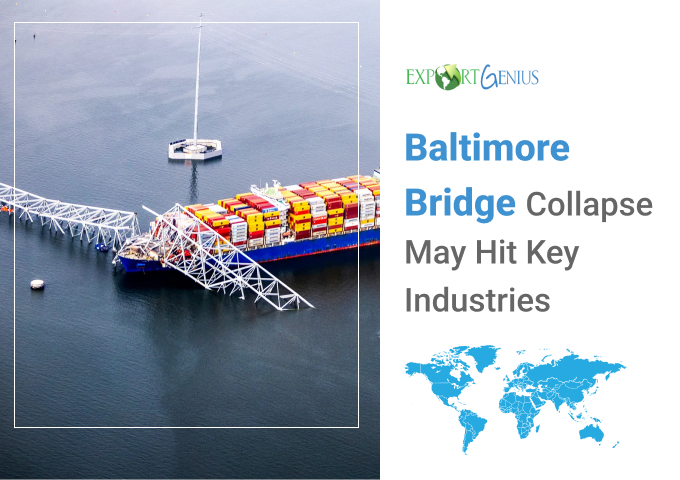The Baltimore Bridge Collapse – Trade Flow of Key Commodities May Hit
11 April 2024

The collapse of the Francis
Scott Bridge in Baltimore, after being struck by a container ship early March
26, 2024 is likely to disrupt the flow of commodities in the key sectors,
namely coal, auto, cobalt, and sugar through the Maryland port. This is a major
hub for warehousing and transshipment of commodities on the US East Coast. How
much US export coal to the world? How much import traffic of cobalt the US
handled in 2023? Get answers to every trade-related question by analyzing US
import-export trade data explained here.
Bridge collapse blocks all
vessel traffic to Port of Baltimore

According to a report, the
Port of Baltimore handled a record volume of 1.1 million twenty-foot equivalent
units of containers in 2023. The port is the largest in the United States of
America of the specialized cargo, with Baltimore the top loading for US thermal
coal exports in 2023.
U.S. coal exports on hold
According to a report, US coal
shipments for departure are on hold as authorities have closed an area within
2,000 yards of the wreckage, blocking access to the Port of Baltimore. Remember
the Port of Baltimore is the second-largest U.S. exporting hub behind Norfolk,
Virginia. A significant disruption of the coal supply chain is anticipated if
other ports can’t surge to provide an outlet for the coal that would have been
exported through Baltimore.
In 2023, the United States of
America exported coal worth USD 15,398 million due to the rising demand for US
coal globally. The consumption of coal in India grew by 8% and China by 5% last
year which forced the countries to import coal from the United States.
Other than India and China,
the Netherlands, Japan, Brazil, Canada, Germany, South Korea, Poland, and Italy
also import coal from the U.S. Here are the values of these countries which
have been taken from the US export database.

|
U.S. Coal Exports |
Value USD Million |
|
World |
15,398 |
|
India |
3,499 |
|
Netherlands |
1,543 |
|
Japan |
1,519 |
|
Brazil |
1,463 |
|
China |
1,094 |
|
Canada |
923 |
|
Germany |
536 |
|
South Korea |
469 |
|
Poland |
433 |
|
Italy |
374 |
The Port of Baltimore
accounted for about 25% of the nation’s coal exports last year, as shipments
surged from about 20 million short tons to 28 million tons, year over year amid
growing demand for U.S. coal in Asia. More than 15 million tons of that was
thermal coal, with most going to India, while about 8 million tons was met
coal, with Japan and China being the biggest buyers.
Among U.S. coal miners who use
the Port of Baltimore to export their commodity, it appears that energy
companies are suffering the brunt of the impact, as vessels can’t get to its
marine terminal.
Closure of the port is
expected to impact US cobalt imports primarily
The closure of Baltimore Port
has halted cobalt shipments, leading to tight inventories and a halt in spot
cobalt offerings in the United States. In 2023, America imported cobalt worth
USD 394 million. Norway was the largest import source, followed by Canada,
Japan, the United Kingdom, Madagascar, Germany, France, Finland, Morocco, and
China. See US import data of cobalt with stats of these countries in
visualization.

|
U.S. Cobalt Imports |
Value USD Million |
|
World |
394 |
|
Norway |
89 |
|
Canada |
84 |
|
Japan |
62 |
|
United Kingdom |
47 |
|
Madagascar |
32 |
|
Germany |
16 |
|
France |
12 |
|
Finland |
9 |
|
Morocco |
7 |
|
China |
6 |
The trade of sugar will be
affected
The Port of Baltimore plays a
significant role in the import and export of sugar. The refiners seem confident
that the closure of the port will not immediately impact short-term operations.
However, the timeline for the re-opening of the port is ambiguous, so the
prognosis is likely to change over time. The effects may not be felt
immediately, but down the road, the U.S. sugar market may experience shortages
and increased prices as well. The chart given shows US trade data of sugar
reported in 2023.

|
US Sugar Imports |
Value USD Million |
US Sugar Exports |
Value USD Million |
|
World |
6,938 |
World |
2,729 |
|
Mexico |
2,170 |
Mexico |
1,112 |
|
Canada |
1,037 |
Canada |
685 |
|
Brazil |
649 |
China |
140 |
|
Germany |
298 |
Japan |
102 |
|
Türkiye |
232 |
New
Zealand |
72 |
Delays of shipments for the
auto industry are expected
The collapse of the Francis
Scott Key Bridge has cast a shadow over Baltimore’s role as a key import hub
for vehicles, primarily affecting auto markets. Asia-Pacific’s largest car
exporters, including China and Japan are likely to bear the brunt of the
incident, as Baltimore’s import activities play a crucial role in their supply
chains. Understand the US auto industry better with data visualization.

|
US Vehicle Imports |
Value USD Million |
US Vehicle Exports |
Value USD Million |
|
World |
381,037 |
World |
152,826 |
|
Mexico |
130,033 |
Canada |
57,725 |
|
Canada |
56,352 |
Mexico |
28,356 |
|
Japan |
50,804 |
Germany |
10,418 |
|
South Korea |
38,421 |
China |
8,138 |
|
Germany |
34,535 |
Australia |
4,680 |
Prices of major commodities are
likely to go up in the international market
In the short run, there will
likely be an increase in shipping costs for coal from West Virginia,
Pennsylvania and Ohio as miners must shift their shipments from Baltimore to
Norfolk. Prices of alloy-grade cobalt in the US climbed on March 26 on higher
offer indications after the port of Baltimore was closed.
The bridge collapse was
unlikely to have any direct impact on global scrap prices since US exporters
still need to compete on price with EU exporters in the Turkish market. There
could be a rise in crude oil due to increased bunker traffic because of the
Baltimore port closure.
Market experts also suggest
that while there may be short-term disruptions, the long-term impacts on the prices
of coal and vehicles are likely to be minimized as global trade adjusts to new
dynamics. Ultimately, most trade through Baltimore will find a new home port,
minimizing price adjustments for coal and vehicles.
If you were to stand on the
load platform at the massive sugar refinery along the Port of Baltimore, you
would see the collapsed remnants of the Francis Scott Key bridge in the
distance. The bridge was a vital piece of the city’s infrastructure and a
notable part of its visual identity. Baltimore is the ninth busiest port in the
U.S. in terms of dollar value and tonnage, so the effects of the Baltimore Bridge
collapse will reverberate far and wide.









